Research Proposal: Human Resources Performance and Training Program
VerifiedAdded on 2020/03/16
|13
|2912
|34
Report
AI Summary
This research proposal investigates the correlation between human resource performance and training programs within organizations. The study aims to determine the impact of training on employee productivity, motivation, and turnover. It identifies independent and dependent variables, sets research objectives, and poses key research questions. The methodology employs secondary data collection and quantitative data analysis, utilizing sources like the CapitalinePlus Database and other research papers. A comprehensive literature review explores concepts of employee training, human resource performance, and the effects of training on productivity, employee motivation, and turnover. The research plan includes a Gantt chart outlining the project timeline. The proposal concludes by highlighting the significance of training programs in enhancing overall organizational performance and employee satisfaction. The research intends to contribute insights into the design and implementation of effective training strategies.
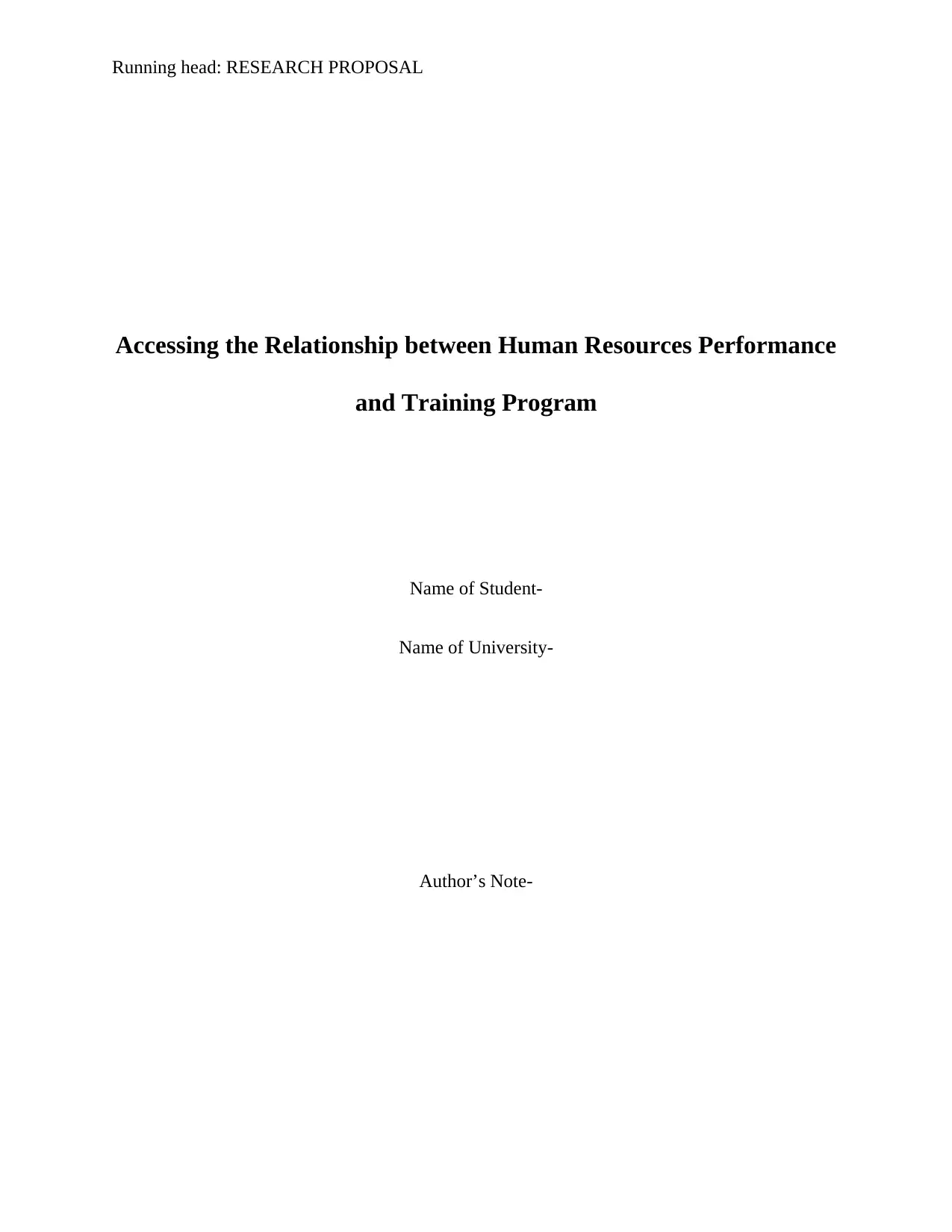
Running head: RESEARCH PROPOSAL
Accessing the Relationship between Human Resources Performance
and Training Program
Name of Student-
Name of University-
Author’s Note-
Accessing the Relationship between Human Resources Performance
and Training Program
Name of Student-
Name of University-
Author’s Note-
Secure Best Marks with AI Grader
Need help grading? Try our AI Grader for instant feedback on your assignments.
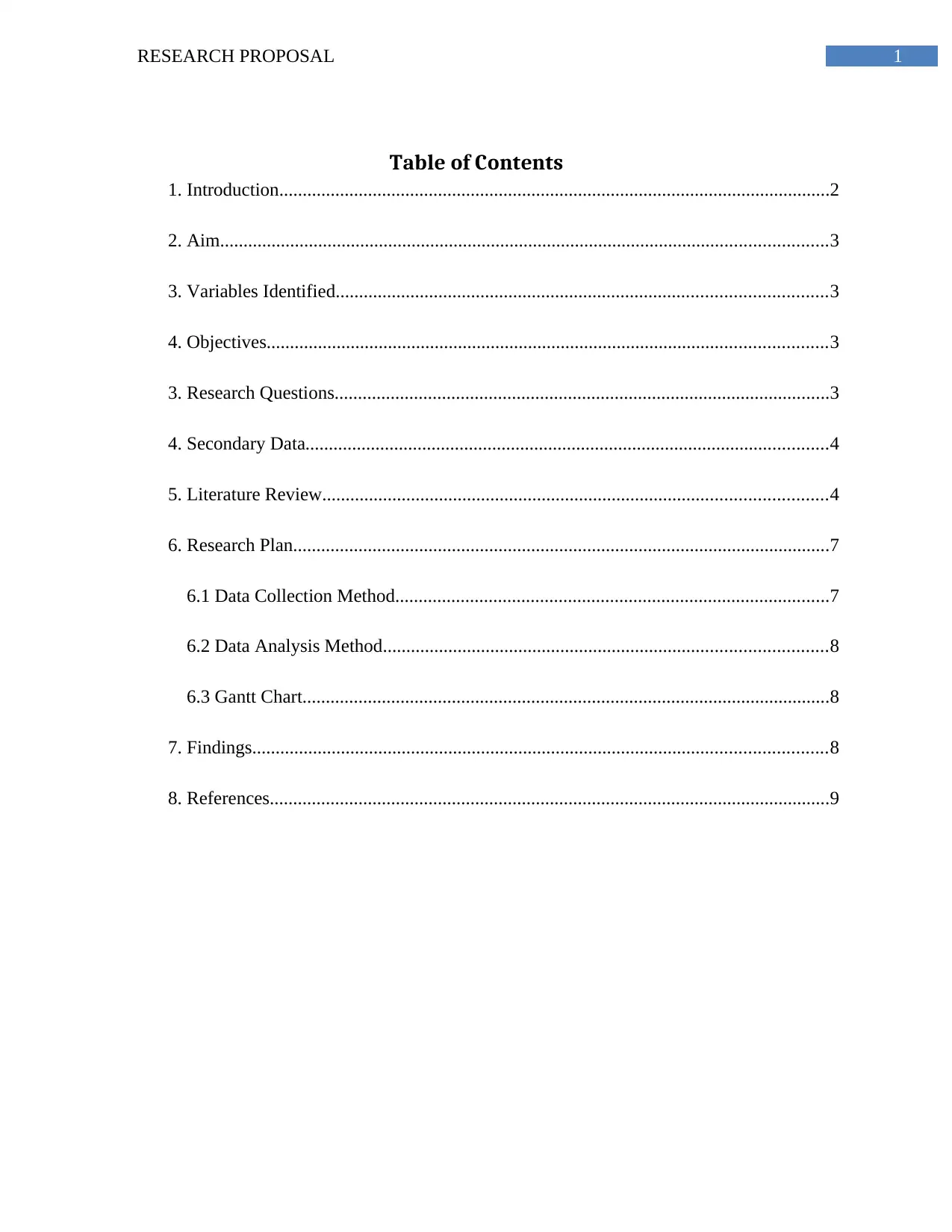
1RESEARCH PROPOSAL
Table of Contents
1. Introduction......................................................................................................................2
2. Aim..................................................................................................................................3
3. Variables Identified.........................................................................................................3
4. Objectives........................................................................................................................3
3. Research Questions..........................................................................................................3
4. Secondary Data................................................................................................................4
5. Literature Review............................................................................................................4
6. Research Plan...................................................................................................................7
6.1 Data Collection Method.............................................................................................7
6.2 Data Analysis Method...............................................................................................8
6.3 Gantt Chart.................................................................................................................8
7. Findings...........................................................................................................................8
8. References........................................................................................................................9
Table of Contents
1. Introduction......................................................................................................................2
2. Aim..................................................................................................................................3
3. Variables Identified.........................................................................................................3
4. Objectives........................................................................................................................3
3. Research Questions..........................................................................................................3
4. Secondary Data................................................................................................................4
5. Literature Review............................................................................................................4
6. Research Plan...................................................................................................................7
6.1 Data Collection Method.............................................................................................7
6.2 Data Analysis Method...............................................................................................8
6.3 Gantt Chart.................................................................................................................8
7. Findings...........................................................................................................................8
8. References........................................................................................................................9
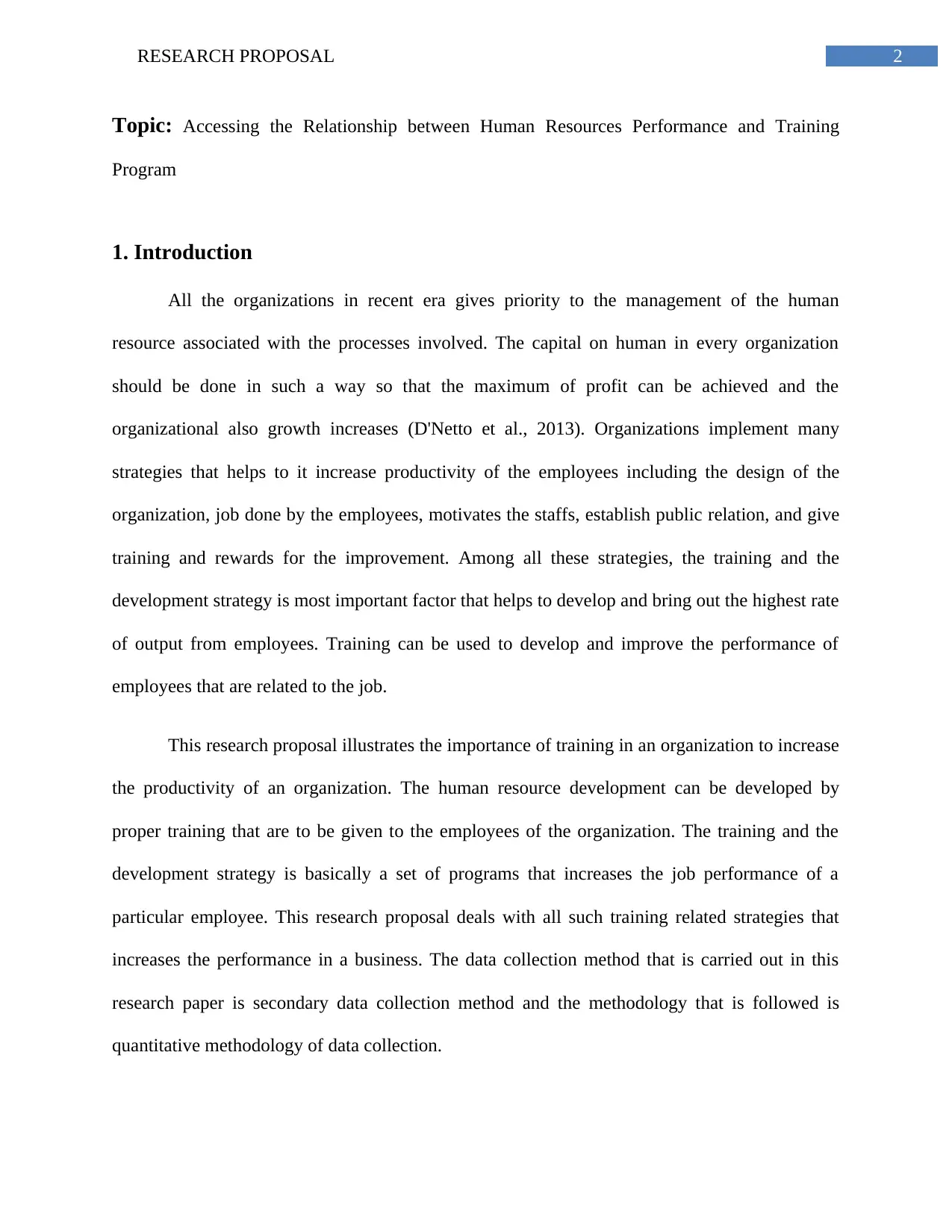
2RESEARCH PROPOSAL
Topic: Accessing the Relationship between Human Resources Performance and Training
Program
1. Introduction
All the organizations in recent era gives priority to the management of the human
resource associated with the processes involved. The capital on human in every organization
should be done in such a way so that the maximum of profit can be achieved and the
organizational also growth increases (D'Netto et al., 2013). Organizations implement many
strategies that helps to it increase productivity of the employees including the design of the
organization, job done by the employees, motivates the staffs, establish public relation, and give
training and rewards for the improvement. Among all these strategies, the training and the
development strategy is most important factor that helps to develop and bring out the highest rate
of output from employees. Training can be used to develop and improve the performance of
employees that are related to the job.
This research proposal illustrates the importance of training in an organization to increase
the productivity of an organization. The human resource development can be developed by
proper training that are to be given to the employees of the organization. The training and the
development strategy is basically a set of programs that increases the job performance of a
particular employee. This research proposal deals with all such training related strategies that
increases the performance in a business. The data collection method that is carried out in this
research paper is secondary data collection method and the methodology that is followed is
quantitative methodology of data collection.
Topic: Accessing the Relationship between Human Resources Performance and Training
Program
1. Introduction
All the organizations in recent era gives priority to the management of the human
resource associated with the processes involved. The capital on human in every organization
should be done in such a way so that the maximum of profit can be achieved and the
organizational also growth increases (D'Netto et al., 2013). Organizations implement many
strategies that helps to it increase productivity of the employees including the design of the
organization, job done by the employees, motivates the staffs, establish public relation, and give
training and rewards for the improvement. Among all these strategies, the training and the
development strategy is most important factor that helps to develop and bring out the highest rate
of output from employees. Training can be used to develop and improve the performance of
employees that are related to the job.
This research proposal illustrates the importance of training in an organization to increase
the productivity of an organization. The human resource development can be developed by
proper training that are to be given to the employees of the organization. The training and the
development strategy is basically a set of programs that increases the job performance of a
particular employee. This research proposal deals with all such training related strategies that
increases the performance in a business. The data collection method that is carried out in this
research paper is secondary data collection method and the methodology that is followed is
quantitative methodology of data collection.
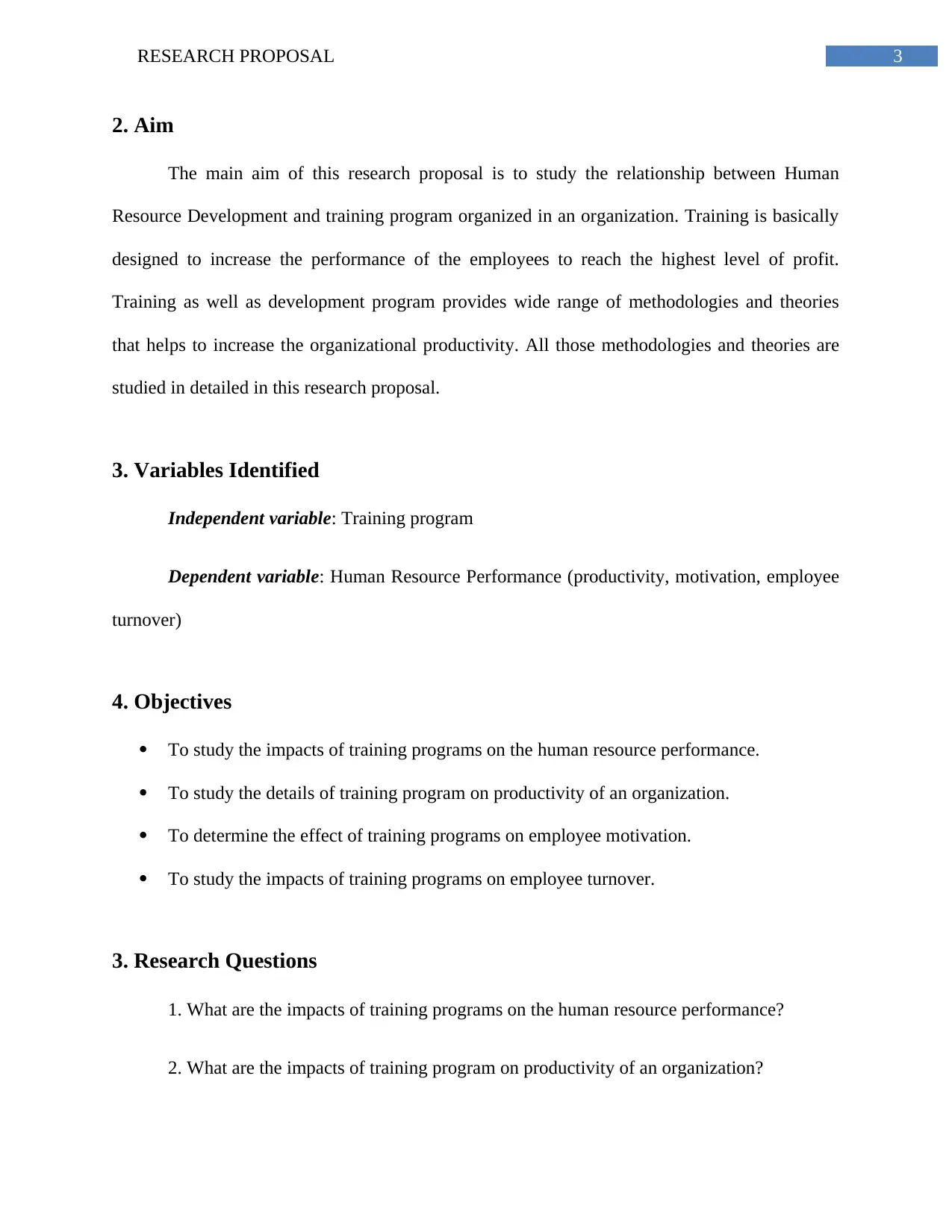
3RESEARCH PROPOSAL
2. Aim
The main aim of this research proposal is to study the relationship between Human
Resource Development and training program organized in an organization. Training is basically
designed to increase the performance of the employees to reach the highest level of profit.
Training as well as development program provides wide range of methodologies and theories
that helps to increase the organizational productivity. All those methodologies and theories are
studied in detailed in this research proposal.
3. Variables Identified
Independent variable: Training program
Dependent variable: Human Resource Performance (productivity, motivation, employee
turnover)
4. Objectives
To study the impacts of training programs on the human resource performance.
To study the details of training program on productivity of an organization.
To determine the effect of training programs on employee motivation.
To study the impacts of training programs on employee turnover.
3. Research Questions
1. What are the impacts of training programs on the human resource performance?
2. What are the impacts of training program on productivity of an organization?
2. Aim
The main aim of this research proposal is to study the relationship between Human
Resource Development and training program organized in an organization. Training is basically
designed to increase the performance of the employees to reach the highest level of profit.
Training as well as development program provides wide range of methodologies and theories
that helps to increase the organizational productivity. All those methodologies and theories are
studied in detailed in this research proposal.
3. Variables Identified
Independent variable: Training program
Dependent variable: Human Resource Performance (productivity, motivation, employee
turnover)
4. Objectives
To study the impacts of training programs on the human resource performance.
To study the details of training program on productivity of an organization.
To determine the effect of training programs on employee motivation.
To study the impacts of training programs on employee turnover.
3. Research Questions
1. What are the impacts of training programs on the human resource performance?
2. What are the impacts of training program on productivity of an organization?
Secure Best Marks with AI Grader
Need help grading? Try our AI Grader for instant feedback on your assignments.
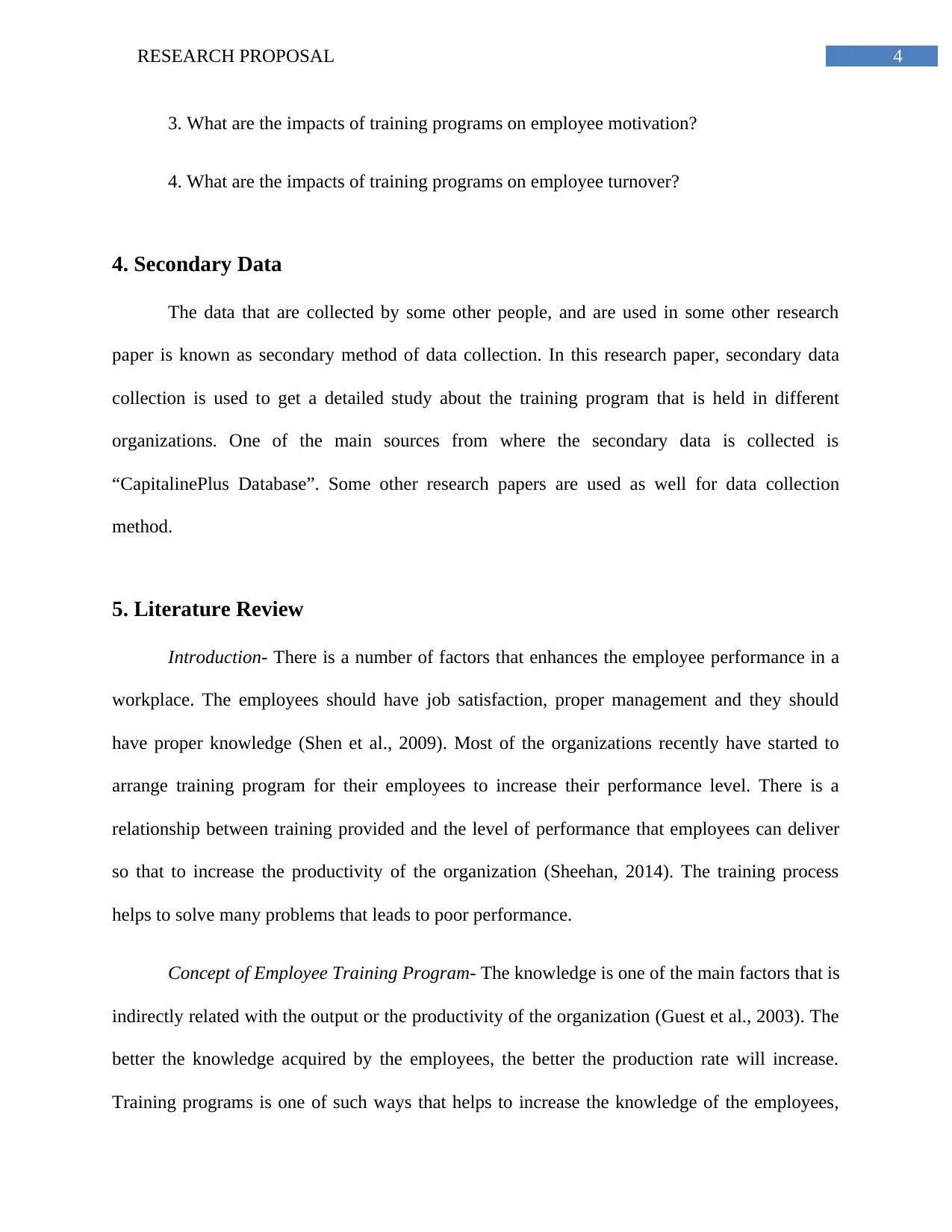
4RESEARCH PROPOSAL
3. What are the impacts of training programs on employee motivation?
4. What are the impacts of training programs on employee turnover?
4. Secondary Data
The data that are collected by some other people, and are used in some other research
paper is known as secondary method of data collection. In this research paper, secondary data
collection is used to get a detailed study about the training program that is held in different
organizations. One of the main sources from where the secondary data is collected is
“CapitalinePlus Database”. Some other research papers are used as well for data collection
method.
5. Literature Review
Introduction- There is a number of factors that enhances the employee performance in a
workplace. The employees should have job satisfaction, proper management and they should
have proper knowledge (Shen et al., 2009). Most of the organizations recently have started to
arrange training program for their employees to increase their performance level. There is a
relationship between training provided and the level of performance that employees can deliver
so that to increase the productivity of the organization (Sheehan, 2014). The training process
helps to solve many problems that leads to poor performance.
Concept of Employee Training Program- The knowledge is one of the main factors that is
indirectly related with the output or the productivity of the organization (Guest et al., 2003). The
better the knowledge acquired by the employees, the better the production rate will increase.
Training programs is one of such ways that helps to increase the knowledge of the employees,
3. What are the impacts of training programs on employee motivation?
4. What are the impacts of training programs on employee turnover?
4. Secondary Data
The data that are collected by some other people, and are used in some other research
paper is known as secondary method of data collection. In this research paper, secondary data
collection is used to get a detailed study about the training program that is held in different
organizations. One of the main sources from where the secondary data is collected is
“CapitalinePlus Database”. Some other research papers are used as well for data collection
method.
5. Literature Review
Introduction- There is a number of factors that enhances the employee performance in a
workplace. The employees should have job satisfaction, proper management and they should
have proper knowledge (Shen et al., 2009). Most of the organizations recently have started to
arrange training program for their employees to increase their performance level. There is a
relationship between training provided and the level of performance that employees can deliver
so that to increase the productivity of the organization (Sheehan, 2014). The training process
helps to solve many problems that leads to poor performance.
Concept of Employee Training Program- The knowledge is one of the main factors that is
indirectly related with the output or the productivity of the organization (Guest et al., 2003). The
better the knowledge acquired by the employees, the better the production rate will increase.
Training programs is one of such ways that helps to increase the knowledge of the employees,
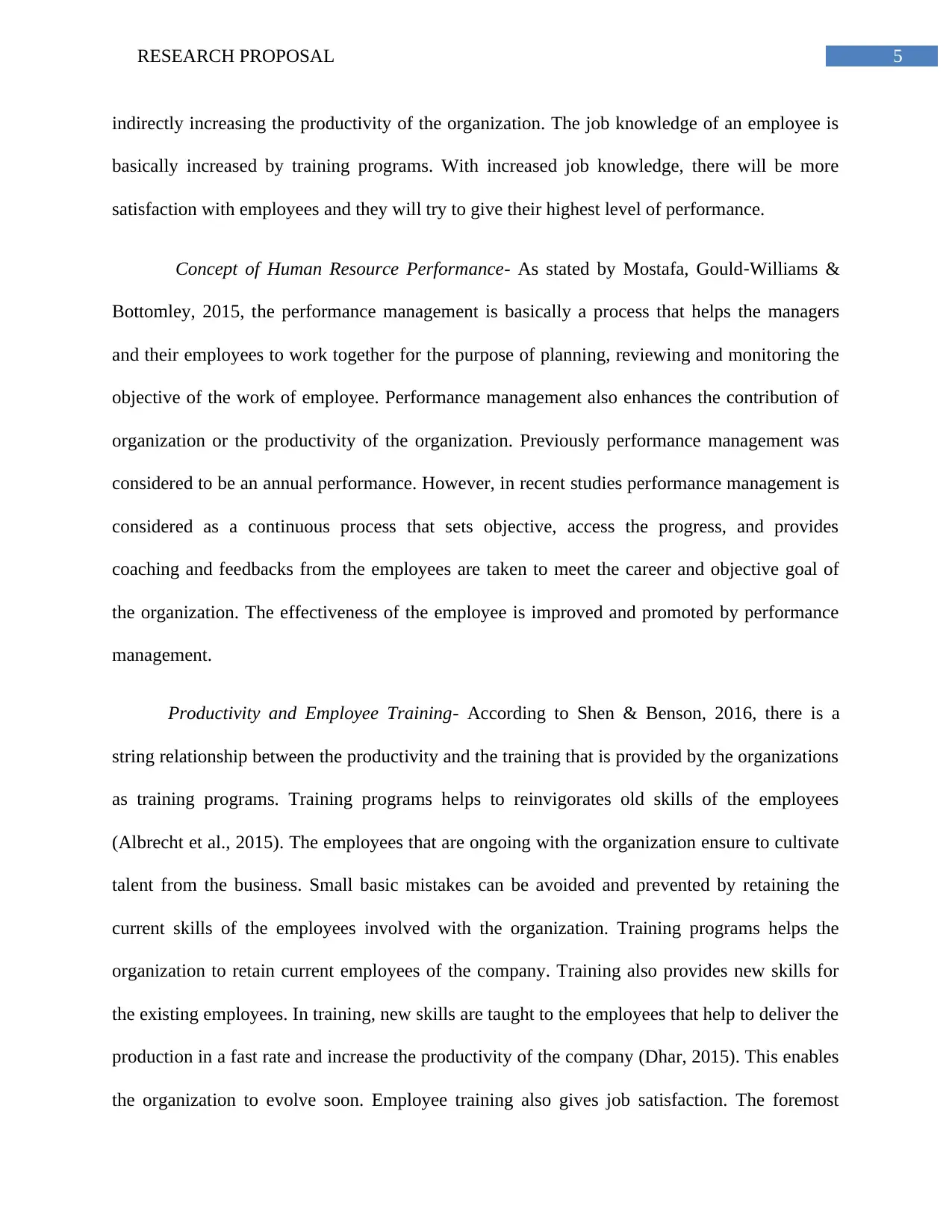
5RESEARCH PROPOSAL
indirectly increasing the productivity of the organization. The job knowledge of an employee is
basically increased by training programs. With increased job knowledge, there will be more
satisfaction with employees and they will try to give their highest level of performance.
Concept of Human Resource Performance- As stated by Mostafa, Gould‐Williams &
Bottomley, 2015, the performance management is basically a process that helps the managers
and their employees to work together for the purpose of planning, reviewing and monitoring the
objective of the work of employee. Performance management also enhances the contribution of
organization or the productivity of the organization. Previously performance management was
considered to be an annual performance. However, in recent studies performance management is
considered as a continuous process that sets objective, access the progress, and provides
coaching and feedbacks from the employees are taken to meet the career and objective goal of
the organization. The effectiveness of the employee is improved and promoted by performance
management.
Productivity and Employee Training- According to Shen & Benson, 2016, there is a
string relationship between the productivity and the training that is provided by the organizations
as training programs. Training programs helps to reinvigorates old skills of the employees
(Albrecht et al., 2015). The employees that are ongoing with the organization ensure to cultivate
talent from the business. Small basic mistakes can be avoided and prevented by retaining the
current skills of the employees involved with the organization. Training programs helps the
organization to retain current employees of the company. Training also provides new skills for
the existing employees. In training, new skills are taught to the employees that help to deliver the
production in a fast rate and increase the productivity of the company (Dhar, 2015). This enables
the organization to evolve soon. Employee training also gives job satisfaction. The foremost
indirectly increasing the productivity of the organization. The job knowledge of an employee is
basically increased by training programs. With increased job knowledge, there will be more
satisfaction with employees and they will try to give their highest level of performance.
Concept of Human Resource Performance- As stated by Mostafa, Gould‐Williams &
Bottomley, 2015, the performance management is basically a process that helps the managers
and their employees to work together for the purpose of planning, reviewing and monitoring the
objective of the work of employee. Performance management also enhances the contribution of
organization or the productivity of the organization. Previously performance management was
considered to be an annual performance. However, in recent studies performance management is
considered as a continuous process that sets objective, access the progress, and provides
coaching and feedbacks from the employees are taken to meet the career and objective goal of
the organization. The effectiveness of the employee is improved and promoted by performance
management.
Productivity and Employee Training- According to Shen & Benson, 2016, there is a
string relationship between the productivity and the training that is provided by the organizations
as training programs. Training programs helps to reinvigorates old skills of the employees
(Albrecht et al., 2015). The employees that are ongoing with the organization ensure to cultivate
talent from the business. Small basic mistakes can be avoided and prevented by retaining the
current skills of the employees involved with the organization. Training programs helps the
organization to retain current employees of the company. Training also provides new skills for
the existing employees. In training, new skills are taught to the employees that help to deliver the
production in a fast rate and increase the productivity of the company (Dhar, 2015). This enables
the organization to evolve soon. Employee training also gives job satisfaction. The foremost
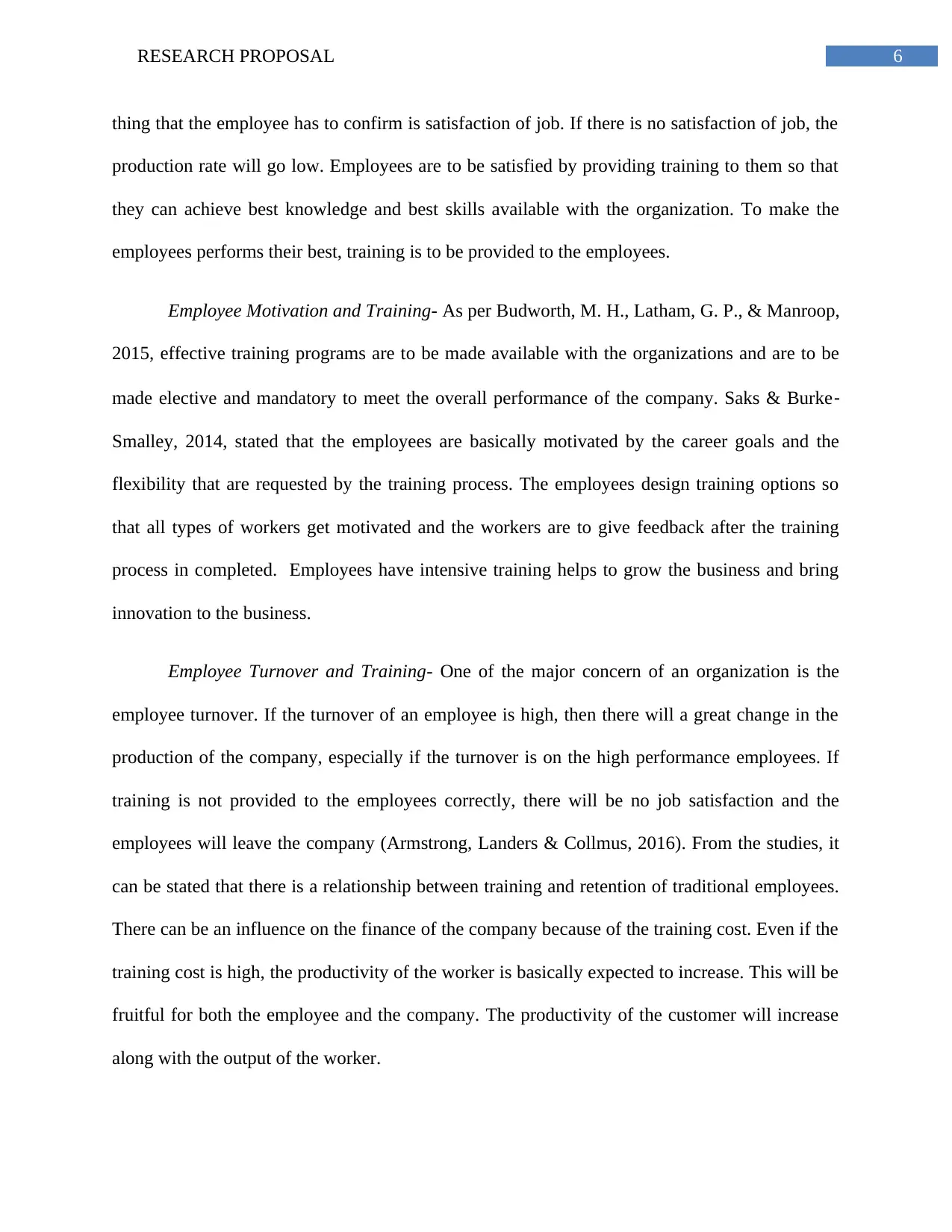
6RESEARCH PROPOSAL
thing that the employee has to confirm is satisfaction of job. If there is no satisfaction of job, the
production rate will go low. Employees are to be satisfied by providing training to them so that
they can achieve best knowledge and best skills available with the organization. To make the
employees performs their best, training is to be provided to the employees.
Employee Motivation and Training- As per Budworth, M. H., Latham, G. P., & Manroop,
2015, effective training programs are to be made available with the organizations and are to be
made elective and mandatory to meet the overall performance of the company. Saks & Burke‐
Smalley, 2014, stated that the employees are basically motivated by the career goals and the
flexibility that are requested by the training process. The employees design training options so
that all types of workers get motivated and the workers are to give feedback after the training
process in completed. Employees have intensive training helps to grow the business and bring
innovation to the business.
Employee Turnover and Training- One of the major concern of an organization is the
employee turnover. If the turnover of an employee is high, then there will a great change in the
production of the company, especially if the turnover is on the high performance employees. If
training is not provided to the employees correctly, there will be no job satisfaction and the
employees will leave the company (Armstrong, Landers & Collmus, 2016). From the studies, it
can be stated that there is a relationship between training and retention of traditional employees.
There can be an influence on the finance of the company because of the training cost. Even if the
training cost is high, the productivity of the worker is basically expected to increase. This will be
fruitful for both the employee and the company. The productivity of the customer will increase
along with the output of the worker.
thing that the employee has to confirm is satisfaction of job. If there is no satisfaction of job, the
production rate will go low. Employees are to be satisfied by providing training to them so that
they can achieve best knowledge and best skills available with the organization. To make the
employees performs their best, training is to be provided to the employees.
Employee Motivation and Training- As per Budworth, M. H., Latham, G. P., & Manroop,
2015, effective training programs are to be made available with the organizations and are to be
made elective and mandatory to meet the overall performance of the company. Saks & Burke‐
Smalley, 2014, stated that the employees are basically motivated by the career goals and the
flexibility that are requested by the training process. The employees design training options so
that all types of workers get motivated and the workers are to give feedback after the training
process in completed. Employees have intensive training helps to grow the business and bring
innovation to the business.
Employee Turnover and Training- One of the major concern of an organization is the
employee turnover. If the turnover of an employee is high, then there will a great change in the
production of the company, especially if the turnover is on the high performance employees. If
training is not provided to the employees correctly, there will be no job satisfaction and the
employees will leave the company (Armstrong, Landers & Collmus, 2016). From the studies, it
can be stated that there is a relationship between training and retention of traditional employees.
There can be an influence on the finance of the company because of the training cost. Even if the
training cost is high, the productivity of the worker is basically expected to increase. This will be
fruitful for both the employee and the company. The productivity of the customer will increase
along with the output of the worker.
Paraphrase This Document
Need a fresh take? Get an instant paraphrase of this document with our AI Paraphraser
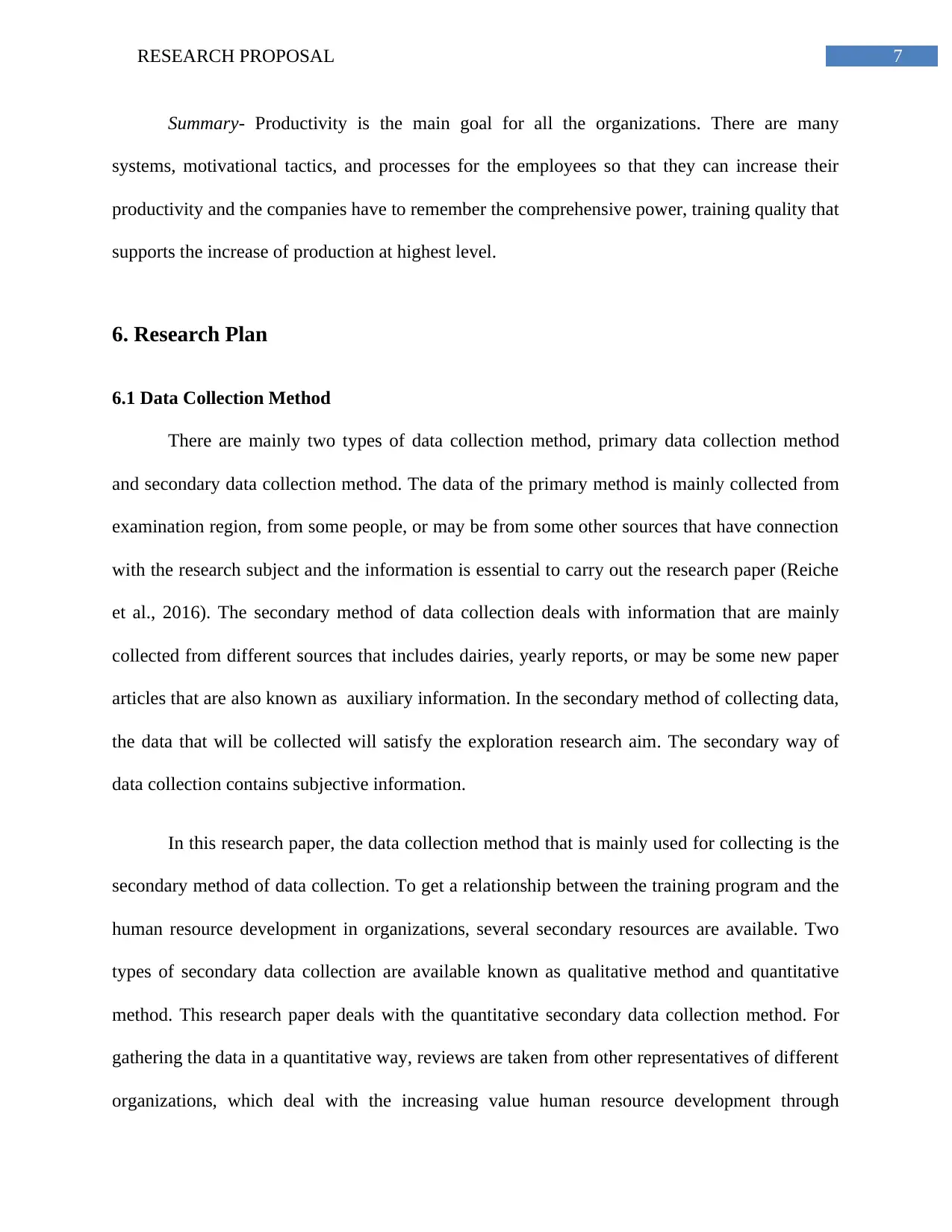
7RESEARCH PROPOSAL
Summary- Productivity is the main goal for all the organizations. There are many
systems, motivational tactics, and processes for the employees so that they can increase their
productivity and the companies have to remember the comprehensive power, training quality that
supports the increase of production at highest level.
6. Research Plan
6.1 Data Collection Method
There are mainly two types of data collection method, primary data collection method
and secondary data collection method. The data of the primary method is mainly collected from
examination region, from some people, or may be from some other sources that have connection
with the research subject and the information is essential to carry out the research paper (Reiche
et al., 2016). The secondary method of data collection deals with information that are mainly
collected from different sources that includes dairies, yearly reports, or may be some new paper
articles that are also known as auxiliary information. In the secondary method of collecting data,
the data that will be collected will satisfy the exploration research aim. The secondary way of
data collection contains subjective information.
In this research paper, the data collection method that is mainly used for collecting is the
secondary method of data collection. To get a relationship between the training program and the
human resource development in organizations, several secondary resources are available. Two
types of secondary data collection are available known as qualitative method and quantitative
method. This research paper deals with the quantitative secondary data collection method. For
gathering the data in a quantitative way, reviews are taken from other representatives of different
organizations, which deal with the increasing value human resource development through
Summary- Productivity is the main goal for all the organizations. There are many
systems, motivational tactics, and processes for the employees so that they can increase their
productivity and the companies have to remember the comprehensive power, training quality that
supports the increase of production at highest level.
6. Research Plan
6.1 Data Collection Method
There are mainly two types of data collection method, primary data collection method
and secondary data collection method. The data of the primary method is mainly collected from
examination region, from some people, or may be from some other sources that have connection
with the research subject and the information is essential to carry out the research paper (Reiche
et al., 2016). The secondary method of data collection deals with information that are mainly
collected from different sources that includes dairies, yearly reports, or may be some new paper
articles that are also known as auxiliary information. In the secondary method of collecting data,
the data that will be collected will satisfy the exploration research aim. The secondary way of
data collection contains subjective information.
In this research paper, the data collection method that is mainly used for collecting is the
secondary method of data collection. To get a relationship between the training program and the
human resource development in organizations, several secondary resources are available. Two
types of secondary data collection are available known as qualitative method and quantitative
method. This research paper deals with the quantitative secondary data collection method. For
gathering the data in a quantitative way, reviews are taken from other representatives of different
organizations, which deal with the increasing value human resource development through
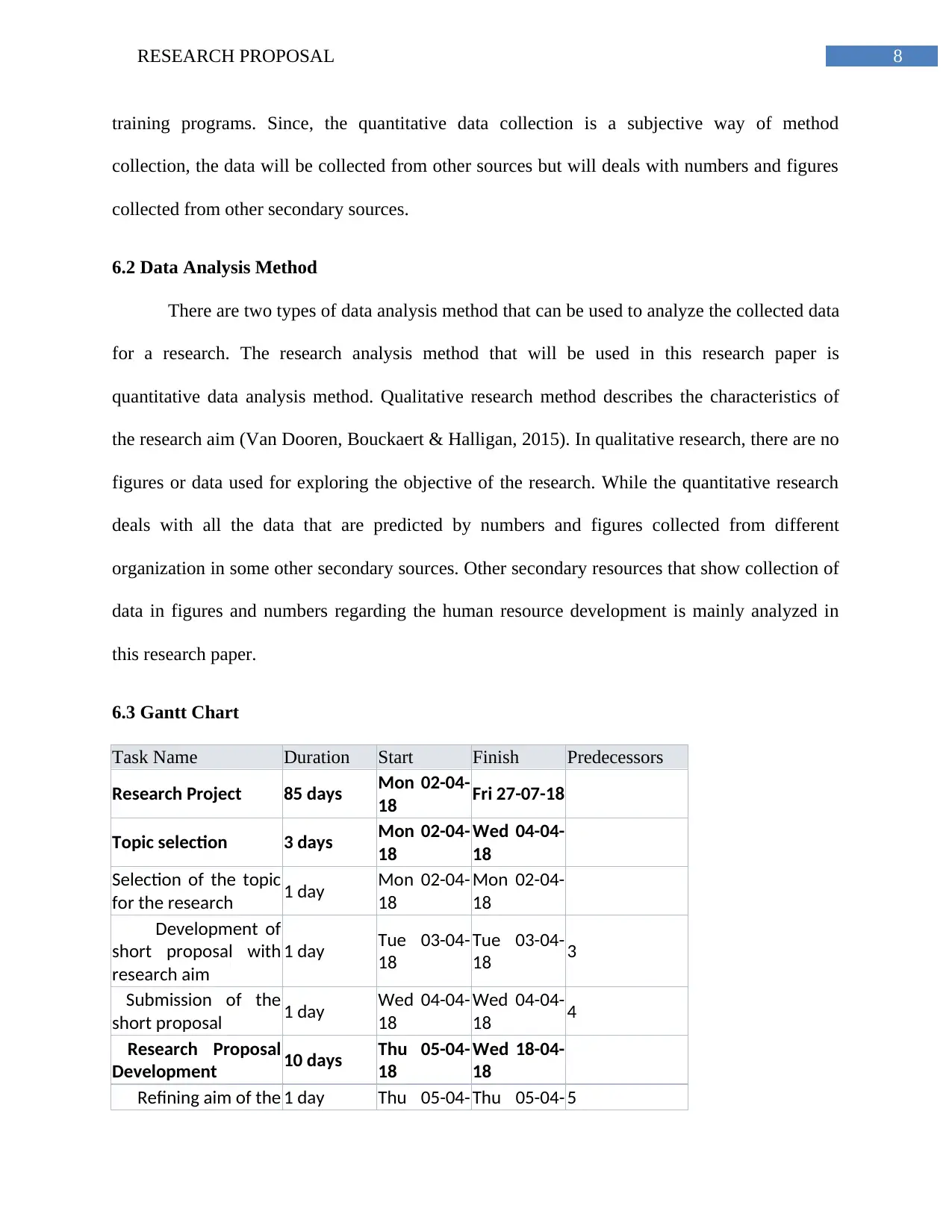
8RESEARCH PROPOSAL
training programs. Since, the quantitative data collection is a subjective way of method
collection, the data will be collected from other sources but will deals with numbers and figures
collected from other secondary sources.
6.2 Data Analysis Method
There are two types of data analysis method that can be used to analyze the collected data
for a research. The research analysis method that will be used in this research paper is
quantitative data analysis method. Qualitative research method describes the characteristics of
the research aim (Van Dooren, Bouckaert & Halligan, 2015). In qualitative research, there are no
figures or data used for exploring the objective of the research. While the quantitative research
deals with all the data that are predicted by numbers and figures collected from different
organization in some other secondary sources. Other secondary resources that show collection of
data in figures and numbers regarding the human resource development is mainly analyzed in
this research paper.
6.3 Gantt Chart
Task Name Duration Start Finish Predecessors
Research Project 85 days Mon 02-04-
18 Fri 27-07-18
Topic selection 3 days Mon 02-04-
18
Wed 04-04-
18
Selection of the topic
for the research 1 day Mon 02-04-
18
Mon 02-04-
18
Development of
short proposal with
research aim
1 day Tue 03-04-
18
Tue 03-04-
18 3
Submission of the
short proposal 1 day Wed 04-04-
18
Wed 04-04-
18 4
Research Proposal
Development 10 days Thu 05-04-
18
Wed 18-04-
18
Refining aim of the 1 day Thu 05-04- Thu 05-04- 5
training programs. Since, the quantitative data collection is a subjective way of method
collection, the data will be collected from other sources but will deals with numbers and figures
collected from other secondary sources.
6.2 Data Analysis Method
There are two types of data analysis method that can be used to analyze the collected data
for a research. The research analysis method that will be used in this research paper is
quantitative data analysis method. Qualitative research method describes the characteristics of
the research aim (Van Dooren, Bouckaert & Halligan, 2015). In qualitative research, there are no
figures or data used for exploring the objective of the research. While the quantitative research
deals with all the data that are predicted by numbers and figures collected from different
organization in some other secondary sources. Other secondary resources that show collection of
data in figures and numbers regarding the human resource development is mainly analyzed in
this research paper.
6.3 Gantt Chart
Task Name Duration Start Finish Predecessors
Research Project 85 days Mon 02-04-
18 Fri 27-07-18
Topic selection 3 days Mon 02-04-
18
Wed 04-04-
18
Selection of the topic
for the research 1 day Mon 02-04-
18
Mon 02-04-
18
Development of
short proposal with
research aim
1 day Tue 03-04-
18
Tue 03-04-
18 3
Submission of the
short proposal 1 day Wed 04-04-
18
Wed 04-04-
18 4
Research Proposal
Development 10 days Thu 05-04-
18
Wed 18-04-
18
Refining aim of the 1 day Thu 05-04- Thu 05-04- 5
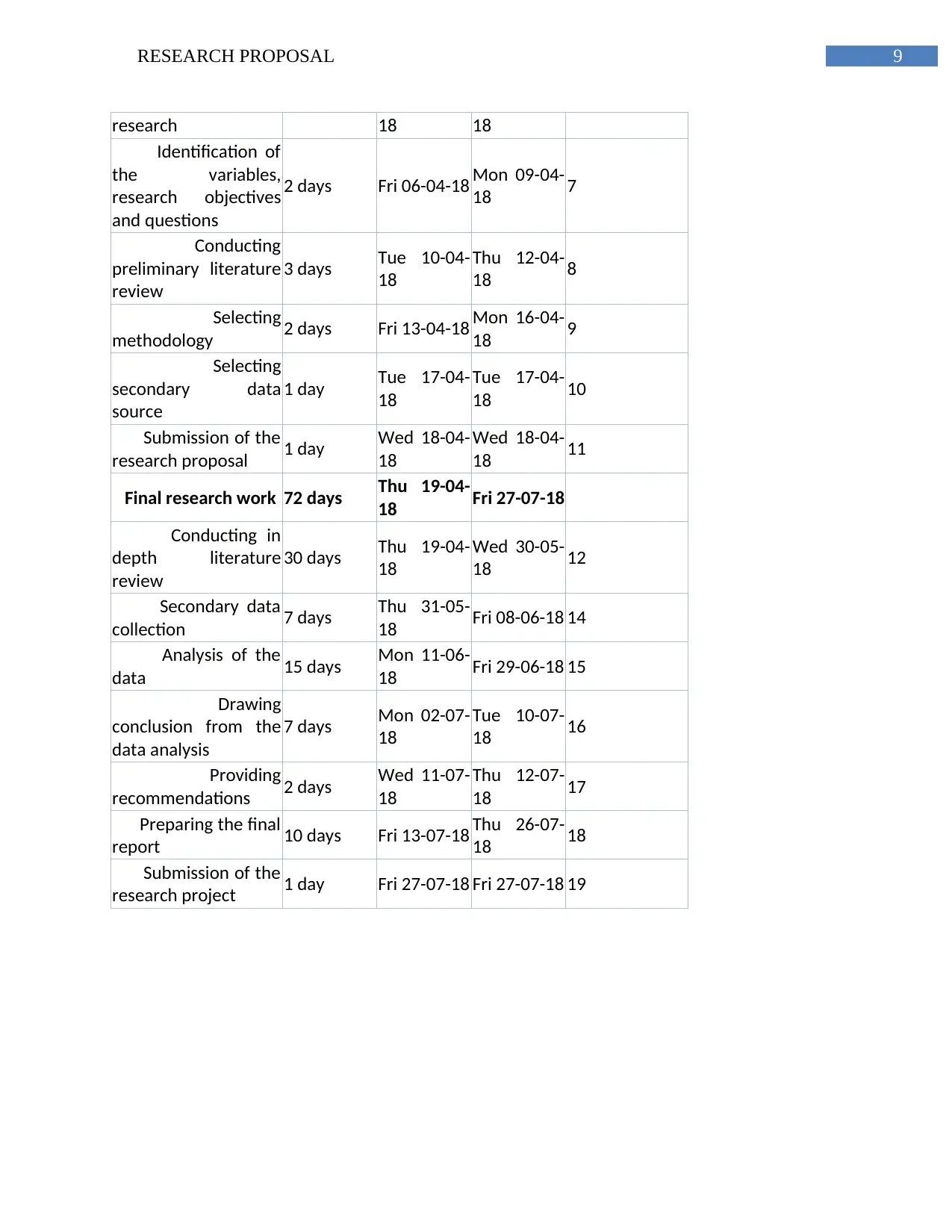
9RESEARCH PROPOSAL
research 18 18
Identification of
the variables,
research objectives
and questions
2 days Fri 06-04-18 Mon 09-04-
18 7
Conducting
preliminary literature
review
3 days Tue 10-04-
18
Thu 12-04-
18 8
Selecting
methodology 2 days Fri 13-04-18 Mon 16-04-
18 9
Selecting
secondary data
source
1 day Tue 17-04-
18
Tue 17-04-
18 10
Submission of the
research proposal 1 day Wed 18-04-
18
Wed 18-04-
18 11
Final research work 72 days Thu 19-04-
18 Fri 27-07-18
Conducting in
depth literature
review
30 days Thu 19-04-
18
Wed 30-05-
18 12
Secondary data
collection 7 days Thu 31-05-
18 Fri 08-06-18 14
Analysis of the
data 15 days Mon 11-06-
18 Fri 29-06-18 15
Drawing
conclusion from the
data analysis
7 days Mon 02-07-
18
Tue 10-07-
18 16
Providing
recommendations 2 days Wed 11-07-
18
Thu 12-07-
18 17
Preparing the final
report 10 days Fri 13-07-18 Thu 26-07-
18 18
Submission of the
research project 1 day Fri 27-07-18 Fri 27-07-18 19
research 18 18
Identification of
the variables,
research objectives
and questions
2 days Fri 06-04-18 Mon 09-04-
18 7
Conducting
preliminary literature
review
3 days Tue 10-04-
18
Thu 12-04-
18 8
Selecting
methodology 2 days Fri 13-04-18 Mon 16-04-
18 9
Selecting
secondary data
source
1 day Tue 17-04-
18
Tue 17-04-
18 10
Submission of the
research proposal 1 day Wed 18-04-
18
Wed 18-04-
18 11
Final research work 72 days Thu 19-04-
18 Fri 27-07-18
Conducting in
depth literature
review
30 days Thu 19-04-
18
Wed 30-05-
18 12
Secondary data
collection 7 days Thu 31-05-
18 Fri 08-06-18 14
Analysis of the
data 15 days Mon 11-06-
18 Fri 29-06-18 15
Drawing
conclusion from the
data analysis
7 days Mon 02-07-
18
Tue 10-07-
18 16
Providing
recommendations 2 days Wed 11-07-
18
Thu 12-07-
18 17
Preparing the final
report 10 days Fri 13-07-18 Thu 26-07-
18 18
Submission of the
research project 1 day Fri 27-07-18 Fri 27-07-18 19
Secure Best Marks with AI Grader
Need help grading? Try our AI Grader for instant feedback on your assignments.
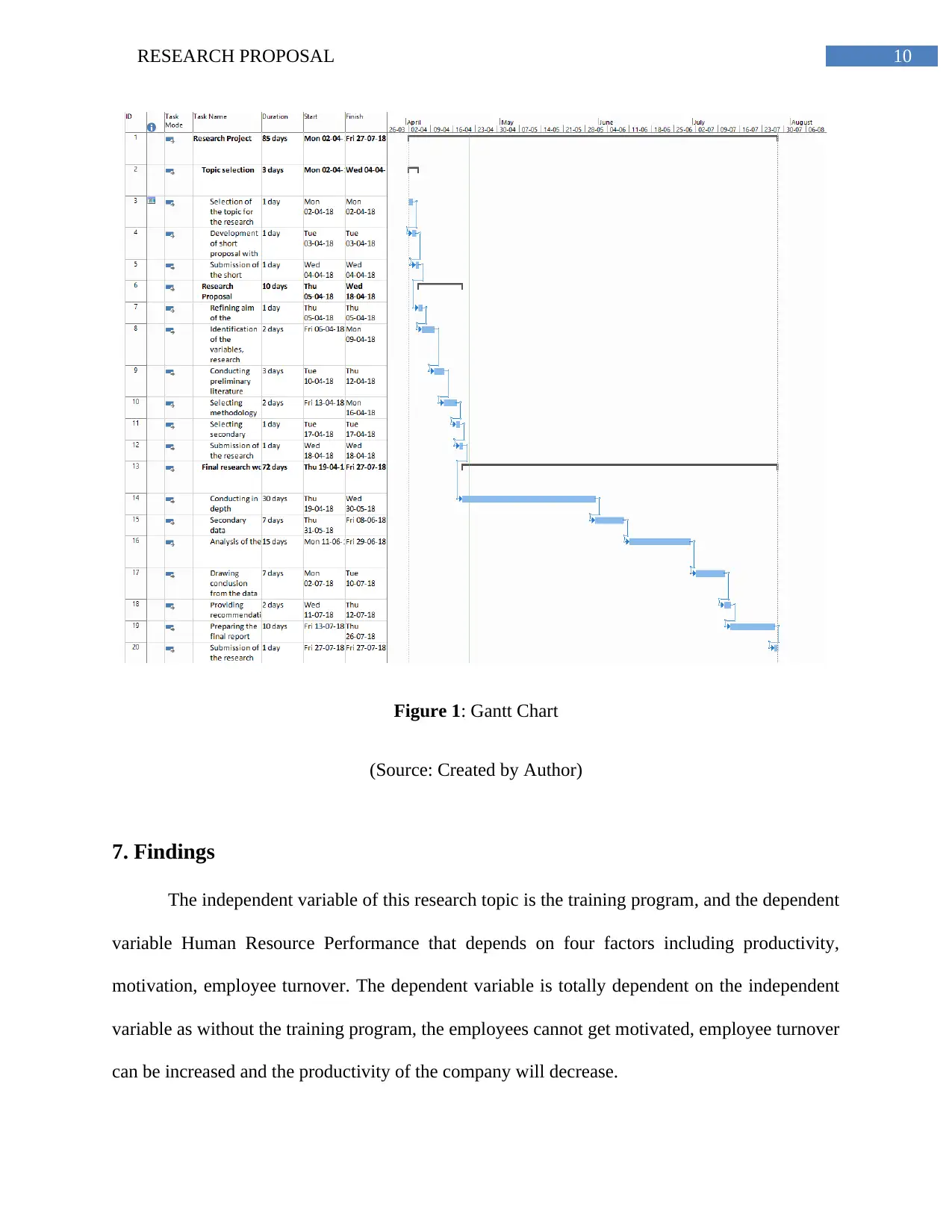
10RESEARCH PROPOSAL
Figure 1: Gantt Chart
(Source: Created by Author)
7. Findings
The independent variable of this research topic is the training program, and the dependent
variable Human Resource Performance that depends on four factors including productivity,
motivation, employee turnover. The dependent variable is totally dependent on the independent
variable as without the training program, the employees cannot get motivated, employee turnover
can be increased and the productivity of the company will decrease.
Figure 1: Gantt Chart
(Source: Created by Author)
7. Findings
The independent variable of this research topic is the training program, and the dependent
variable Human Resource Performance that depends on four factors including productivity,
motivation, employee turnover. The dependent variable is totally dependent on the independent
variable as without the training program, the employees cannot get motivated, employee turnover
can be increased and the productivity of the company will decrease.
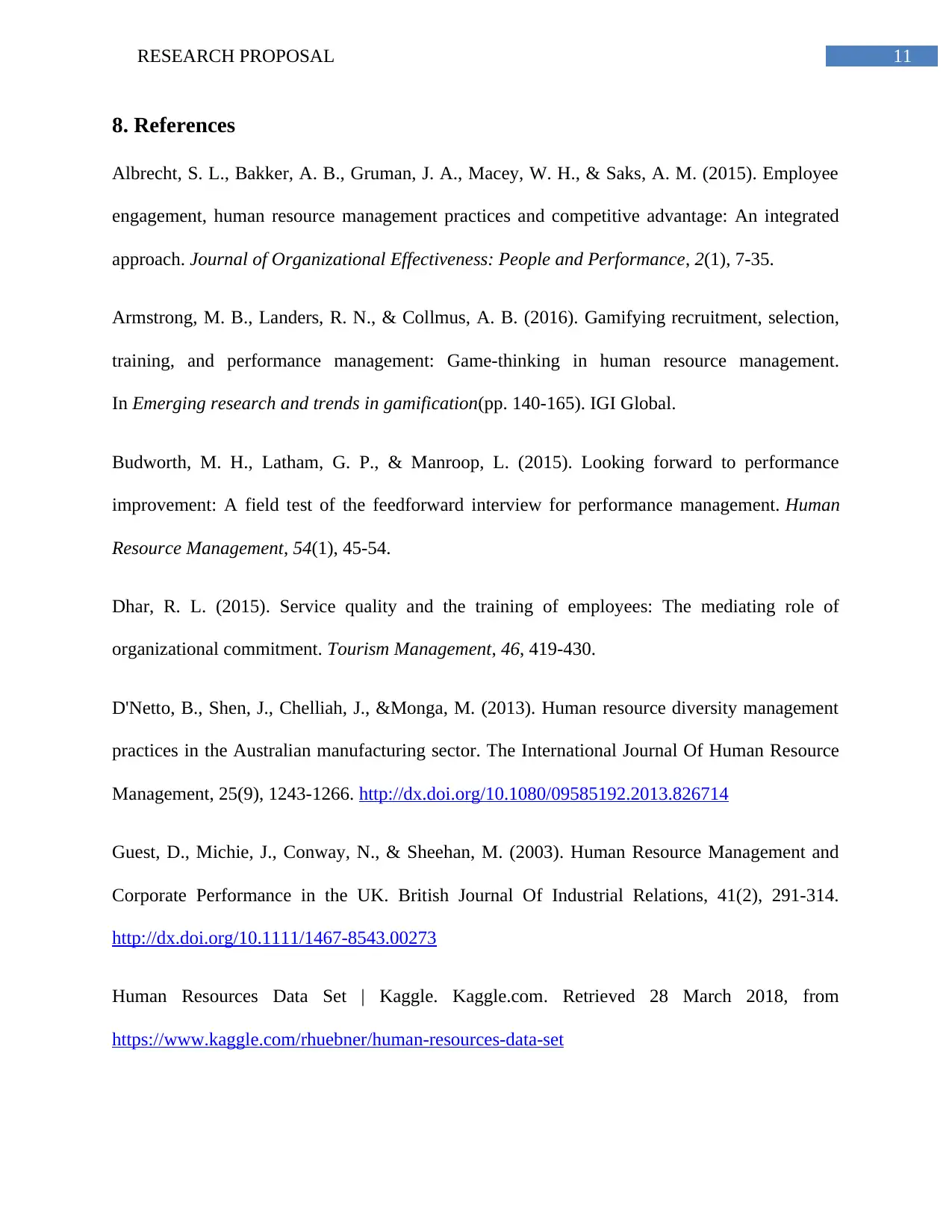
11RESEARCH PROPOSAL
8. References
Albrecht, S. L., Bakker, A. B., Gruman, J. A., Macey, W. H., & Saks, A. M. (2015). Employee
engagement, human resource management practices and competitive advantage: An integrated
approach. Journal of Organizational Effectiveness: People and Performance, 2(1), 7-35.
Armstrong, M. B., Landers, R. N., & Collmus, A. B. (2016). Gamifying recruitment, selection,
training, and performance management: Game-thinking in human resource management.
In Emerging research and trends in gamification(pp. 140-165). IGI Global.
Budworth, M. H., Latham, G. P., & Manroop, L. (2015). Looking forward to performance
improvement: A field test of the feedforward interview for performance management. Human
Resource Management, 54(1), 45-54.
Dhar, R. L. (2015). Service quality and the training of employees: The mediating role of
organizational commitment. Tourism Management, 46, 419-430.
D'Netto, B., Shen, J., Chelliah, J., &Monga, M. (2013). Human resource diversity management
practices in the Australian manufacturing sector. The International Journal Of Human Resource
Management, 25(9), 1243-1266. http://dx.doi.org/10.1080/09585192.2013.826714
Guest, D., Michie, J., Conway, N., & Sheehan, M. (2003). Human Resource Management and
Corporate Performance in the UK. British Journal Of Industrial Relations, 41(2), 291-314.
http://dx.doi.org/10.1111/1467-8543.00273
Human Resources Data Set | Kaggle. Kaggle.com. Retrieved 28 March 2018, from
https://www.kaggle.com/rhuebner/human-resources-data-set
8. References
Albrecht, S. L., Bakker, A. B., Gruman, J. A., Macey, W. H., & Saks, A. M. (2015). Employee
engagement, human resource management practices and competitive advantage: An integrated
approach. Journal of Organizational Effectiveness: People and Performance, 2(1), 7-35.
Armstrong, M. B., Landers, R. N., & Collmus, A. B. (2016). Gamifying recruitment, selection,
training, and performance management: Game-thinking in human resource management.
In Emerging research and trends in gamification(pp. 140-165). IGI Global.
Budworth, M. H., Latham, G. P., & Manroop, L. (2015). Looking forward to performance
improvement: A field test of the feedforward interview for performance management. Human
Resource Management, 54(1), 45-54.
Dhar, R. L. (2015). Service quality and the training of employees: The mediating role of
organizational commitment. Tourism Management, 46, 419-430.
D'Netto, B., Shen, J., Chelliah, J., &Monga, M. (2013). Human resource diversity management
practices in the Australian manufacturing sector. The International Journal Of Human Resource
Management, 25(9), 1243-1266. http://dx.doi.org/10.1080/09585192.2013.826714
Guest, D., Michie, J., Conway, N., & Sheehan, M. (2003). Human Resource Management and
Corporate Performance in the UK. British Journal Of Industrial Relations, 41(2), 291-314.
http://dx.doi.org/10.1111/1467-8543.00273
Human Resources Data Set | Kaggle. Kaggle.com. Retrieved 28 March 2018, from
https://www.kaggle.com/rhuebner/human-resources-data-set
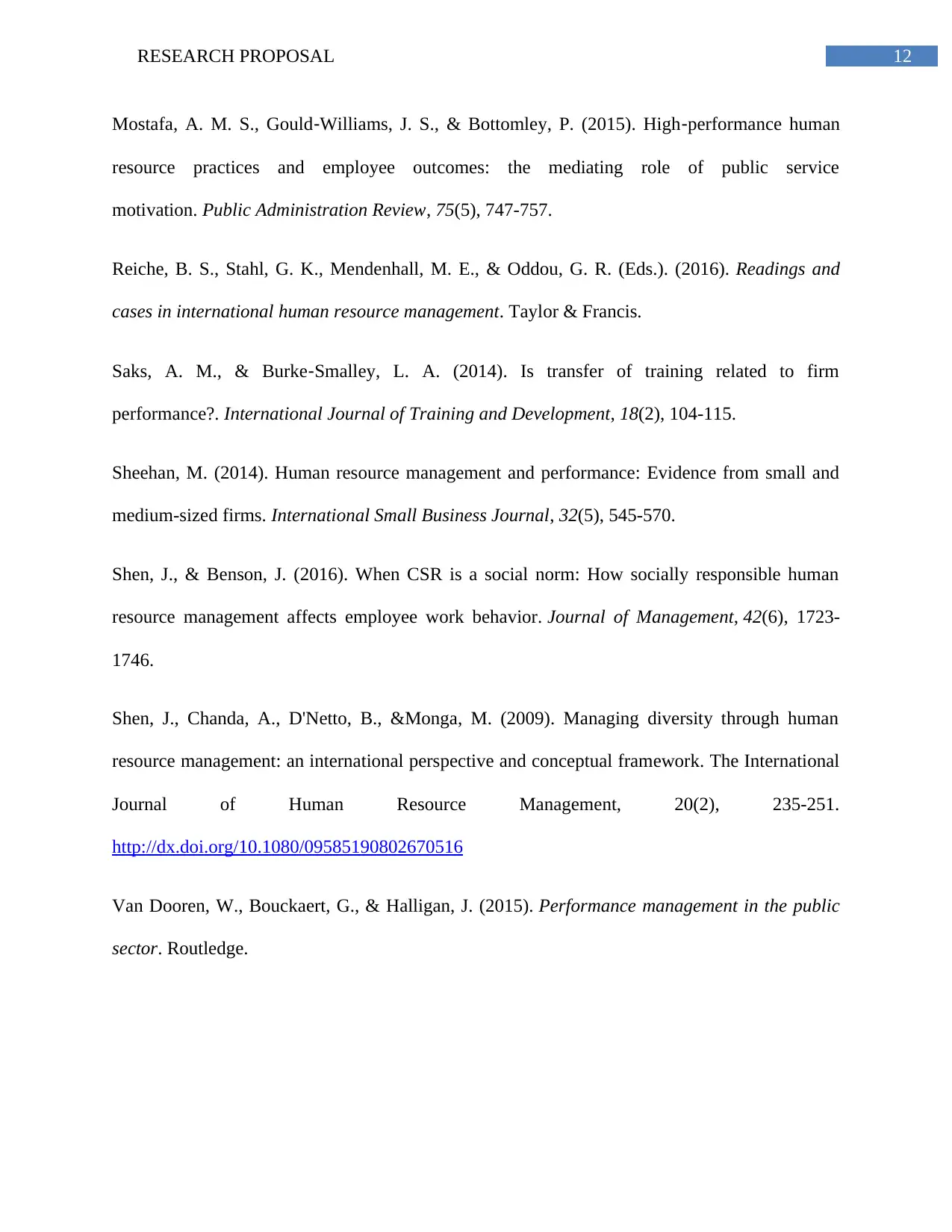
12RESEARCH PROPOSAL
Mostafa, A. M. S., Gould‐Williams, J. S., & Bottomley, P. (2015). High‐performance human
resource practices and employee outcomes: the mediating role of public service
motivation. Public Administration Review, 75(5), 747-757.
Reiche, B. S., Stahl, G. K., Mendenhall, M. E., & Oddou, G. R. (Eds.). (2016). Readings and
cases in international human resource management. Taylor & Francis.
Saks, A. M., & Burke‐Smalley, L. A. (2014). Is transfer of training related to firm
performance?. International Journal of Training and Development, 18(2), 104-115.
Sheehan, M. (2014). Human resource management and performance: Evidence from small and
medium-sized firms. International Small Business Journal, 32(5), 545-570.
Shen, J., & Benson, J. (2016). When CSR is a social norm: How socially responsible human
resource management affects employee work behavior. Journal of Management, 42(6), 1723-
1746.
Shen, J., Chanda, A., D'Netto, B., &Monga, M. (2009). Managing diversity through human
resource management: an international perspective and conceptual framework. The International
Journal of Human Resource Management, 20(2), 235-251.
http://dx.doi.org/10.1080/09585190802670516
Van Dooren, W., Bouckaert, G., & Halligan, J. (2015). Performance management in the public
sector. Routledge.
Mostafa, A. M. S., Gould‐Williams, J. S., & Bottomley, P. (2015). High‐performance human
resource practices and employee outcomes: the mediating role of public service
motivation. Public Administration Review, 75(5), 747-757.
Reiche, B. S., Stahl, G. K., Mendenhall, M. E., & Oddou, G. R. (Eds.). (2016). Readings and
cases in international human resource management. Taylor & Francis.
Saks, A. M., & Burke‐Smalley, L. A. (2014). Is transfer of training related to firm
performance?. International Journal of Training and Development, 18(2), 104-115.
Sheehan, M. (2014). Human resource management and performance: Evidence from small and
medium-sized firms. International Small Business Journal, 32(5), 545-570.
Shen, J., & Benson, J. (2016). When CSR is a social norm: How socially responsible human
resource management affects employee work behavior. Journal of Management, 42(6), 1723-
1746.
Shen, J., Chanda, A., D'Netto, B., &Monga, M. (2009). Managing diversity through human
resource management: an international perspective and conceptual framework. The International
Journal of Human Resource Management, 20(2), 235-251.
http://dx.doi.org/10.1080/09585190802670516
Van Dooren, W., Bouckaert, G., & Halligan, J. (2015). Performance management in the public
sector. Routledge.
1 out of 13
Related Documents
Your All-in-One AI-Powered Toolkit for Academic Success.
+13062052269
info@desklib.com
Available 24*7 on WhatsApp / Email
![[object Object]](/_next/static/media/star-bottom.7253800d.svg)
Unlock your academic potential
© 2024 | Zucol Services PVT LTD | All rights reserved.




